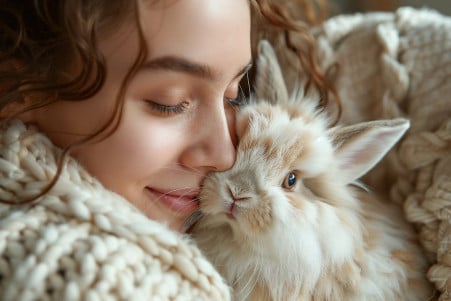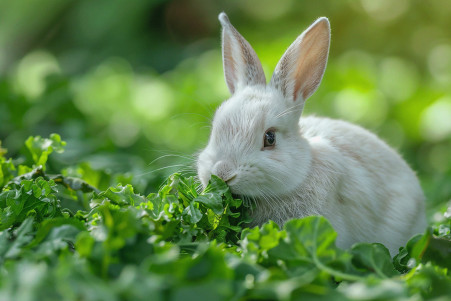Do Rabbits Purr? Exploring a Rabbit's Unique Vocalizations
5 May 2024 • Updated 4 May 2024

Do rabbits purr like cats, or do they communicate differently with us humans? While rabbits don't actually purr, they do make a similar soft humming sound when they feel content and happy. This gentle noise is called "teeth purring" and is produced by gently grinding their teeth together. So while not a true purr, rabbits use this behavior to convey pleasure and contentment in a way humans can easily recognize.
We'll examine scientific research from experts in animal behavior, biology, and veterinary science to better understand this tooth purring phenomenon in rabbits. By looking closely at their physiology and cognitive traits, you'll gain insights into how rabbits communicate emotions through distinct vocalizations and body language. This exploration will deepen your appreciation for these delightful creatures and their subtle ways of expressing themselves.
Do Rabbits Purr?
Rabbit Tooth Purring: What It Means and Why Rabbits Do It
Rabbit tooth purring is a sign that your rabbit is happy and comfortable, much like a cat's purr. As Bunnylady.com notes, this behavior is characterized by the rabbit gently grinding its teeth, often while its whiskers twitch and its body vibrates if you're petting it. It's also completely normal for rabbits to grind their teeth occasionally to keep them from getting too long.
On the other hand, loud or harsh grinding is a sign that your rabbit is in pain or is dealing with some other health problem. According to RabbitsLife.com, loud grinding is a sign of physical pain, stress from environmental factors like loud noises or being kept in a small cage, and even emotional pain. As shown in the Still Waters Rabbitry video, excessive grinding can also be a sign of gastrointestinal issues, such as gas from eating the wrong foods.
To tell the difference between purring and grinding, pay attention to the volume and speed of the sound, as well as the rabbit's other behaviors and body language. If the grinding is especially loud or fast, or if your rabbit is showing other signs of distress, like trembling or bulging eyes, it's a good idea to take them to the vet to rule out any health problems. Knowing what to listen for can help you better understand your rabbit's mood and make sure they're healthy.
Understanding Rabbit Body Language and Sounds
In addition to tooth purring, rabbits use a range of other body language and vocalizations to communicate. Positive behaviors, according to BeChewy, include binkying (jumping and twisting), licking, nudging, loafing, and soft clucking or buzzing noises.
Meanwhile, Home & Roost lists negative behaviors to look out for, such as foot thumping, growling, snorting, hissing, hiding, ears pressed flat against the head, stiff body language, and whining or screaming noises. These behaviors are important to understand so that you can better assess a rabbit's emotional state, as well as their needs and general health.
Through careful attention to a rabbit's body language and the situations in which they make sounds, as described by the RSPCA and Bunnylady.com, owners can determine whether a rabbit is happy, scared, angry, or in pain. This can help ensure that a rabbit's needs are met and that a strong bond is formed based on trust.
How to Bond and Build Trust With Your Rabbit
Rabbits are social animals that form strong bonds with their human companions. In fact, PetHelpful notes that rabbits need to bond with their owners to be happy and healthy. However, because they are prey animals, they are naturally shy, anxious, or fearful when they first meet new people.
To bond with your rabbit, you need to meet them at their level by sitting or lying on the ground, according to Rabbit.org. In addition, speaking in a quiet voice, letting the rabbit come to you, and using treats to encourage positive interactions can all help you bond with your rabbit, according to Bunnylady.com. Petting, holding, playing with toys, and even grooming your rabbit can also help you bond with them.
If you are patient, respectful, and understand your rabbit's body language, you can develop a strong, trusting bond with your rabbit that will help them live their best life. In fact, PetHelpful notes that the most important thing to remember is that you should focus on building trust with your rabbit instead of training or taming them.
Most Common Health Problems and How to Tell If Your Rabbit Is Sick
As with any animal, rabbits are prone to a number of health problems that owners should be on the lookout for. Some of the most common health issues in rabbits include gastrointestinal stasis, dental disease, respiratory infections, and reproductive problems such as uterine tumors. According to PetMD, gastrointestinal stasis is a life-threatening condition in rabbits that can be caused by dental issues, infections, or stress if not treated quickly.
Some of the most common signs that your rabbit is sick include changes in appetite, lethargy, abnormal feces, teeth grinding, breathing problems, and unusual vocalizations or postures, according to Oxbow Animal Health and the 2024 Pet Owners' Manual. Other potential health problems to be aware of include fly strike, sore hocks due to improper housing, and viral diseases like myxomatosis, according to the RSPCA.
If you notice any changes in your rabbit's behavior, eating habits, or health and wellness, it's important to take them to the vet as soon as possible. Many of the most common health problems in rabbits can be prevented or managed with proper care and attention.
How to Make Sure Your Rabbit Stays Healthy and Happy
In addition to regular veterinary care, proper housing, diet, and environmental enrichment are important to a rabbit's overall health and happiness, says Rabbit.org. This means that rabbits should be kept in a large, safe, and clean enclosure that includes hiding places, chew toys, and room to move around. PetMD also suggests that rabbits should be fed a diet that is made up mostly of unlimited hay, as well as fresh vegetables and a small number of pellets, and that they should always have access to fresh water.
In addition, Vetwest Veterinary Clinics explains that regular nail trims, grooming, and litter box training can help ensure that rabbits are comfortable and clean. If rabbits are kept in the right conditions and are taken to the vet as soon as they show signs of illness, they can live long, healthy lives according to the RSPCA Knowledgebase. By making sure that rabbits are kept in a safe, enriched environment and that all of their needs are met, owners can make sure that their pets are happy and healthy.
Conclusion: Understanding a Rabbit's Special Language and Needs
Rabbits have a rich and varied way of communicating with their human friends, including a number of vocalizations and body language cues in addition to purring. Knowing what these cues like tooth purring, thumping, and certain body positions mean is essential to understanding a rabbit's emotional state. This, in turn, is important for building a strong relationship with a rabbit, ensuring their needs are met, and helping them feel secure, happy, and well-cared for.
Although rabbits are high-maintenance pets, their ability to express happiness through the soothing vibrations of tooth purring make the work of caring for them more than worth it. By being patient and understanding of their natural behaviors and making sure their needs are met, rabbit owners can come to love these charming pets.


